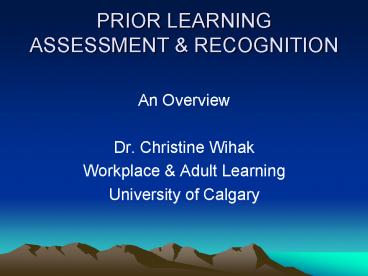PRIOR LEARNING ASSESSMENT - PowerPoint PPT Presentation
1 / 26
Title:
PRIOR LEARNING ASSESSMENT
Description:
Brief look at research on ITIs (internationally trained ... Diagram Observe Categorise Inquire. Delineate Organise Translate Classify. Apply. Generalize ... – PowerPoint PPT presentation
Number of Views:32
Avg rating:3.0/5.0
Title: PRIOR LEARNING ASSESSMENT
1
PRIOR LEARNING ASSESSMENT RECOGNITION
- An Overview
- Dr. Christine Wihak
- Workplace Adult Learning
- University of Calgary
2
- Definition of PLAR
- Brief look at research on ITIs (internationally
trained immigrants) and PLAR - Description of PLAR process
- PLAR resources available in Canada
3
What is PLAR?
- The practice of reviewing, evaluating, and
acknowledging the information, skills, and
understanding that adult learners have gained
through experiential or self-directed (informal)
and/or non-credit courses and workshops
(nonformal) learning, rather than through formal
education - (Thomas, 2000).
4
Why do PLAR?
- For immigrants, there is the potential for
Canadian credentialing of foreign experience and
training and connecting them to the right work - Potential benefits of PLAR to ITIs
- It reduces time needed to complete credential
dont need to re-learn material learned elsewhere - It reduces costs of completing credential
- It improves confidence
5
Research on PLAR and immigrants
- Livingstone, Raykov, Turner (2005) cross-Canada
survey on Work and Learning - Found two-thirds of immigrant respondents
interested in gaining recognition for informal
and non-formal learning - Saskatchewan survey of immigrants (Shmyr, 2003)
found that none of the respondents had heard of
PLAR (process, methods or term) - Learning Innovations Forum doing research on an
e-portfolio system for immigrants
(http//www.futured.com/documents/LIfIAProjectAnno
uncementAugust05.pdf) - Wihak working on proposal to do applied research
on PLAR and ITIs in Canadian post-secondary
setting
6
PLAR for Immigrants has 3 parts..
- Assessment of formal international credentials
WES, 5 provincial agencies, professional
associations, regulatory bodies, sector councils,
h.e. institutions - Assessment of language skills in English and
French standard tests, ESL providers etc. - PLAR focus assessment of work and other
experience for formal educational credit
recognition or to meet job requirements.
7
Informal and non-formal
Internationally Trained Immigrant
Formal Credentials
Language Proficiency
Experience
8
Internationally Trained Immigrant
Formal credentials
Language Proficiency
Experience
Employment
9
Internationally Trained Immigrant
Formal credentials
Language Proficiency
Experience
Competencies, knowledge, skills and attributes of
the job
Employment
10
Internationally Trained Immigrant
Formal credentials
Language Proficiency
Experience
Competencies, knowledge, skills and attributes of
the ITI
Competencies, knowledge, skills and attributes of
the job
Employment
11
Internationally Trained Immigrant
Formal credentials
Language Proficiency
Experience
Competencies, knowledge, skills and attributes of
the ITI
THE FIT
THE GAP THE BRIDGE
Competencies, knowledge, skills and attributes of
the job
Employment
12
Internationally Trained Immigrant
Formal credentials
Language Proficiency
Experience
FCR
e.g. TOEFL
PLAR/APEL
Competencies, knowledge, skills and attributes
THE GAP THE BRIDGE
THE FIT
Competencies, knowledge, skills and attributes
Employment
13
Nonformal learning
- PLAR can recognize learning gained outside of
formal education system - For ITIs, formal learning gained in foreign
education system sometimes not recognized by
through usual channels of Canadian formal
education system - Foreign formal education might be recognized
through PLAR process of recognizing nonformal
learning
14
How is PLAR done?
- Several different methods for assessing learning
- Interviews, demonstrations
- Review of job-based training
- Review of foreign credentials not recognized
through credential evaluation services - Challenge exams
- Portfolio development and review
15
Building a Portfolio
- Portfolio commonly used for PLAR
- Steps in portfolio development
- Create a learning narrative that describes
significant learning experiences - Identify specific learning in each learning
experience - Create learning statements
- Document learning statements
16
How to Describe Learning Blooms Taxonomy
Know Describe List State Tell Recall Recognize Identify Name Note Quote Locate Comprehend Translate Organize Abbreviate Clarify Symbolism Transfer Define Interpret Infer Predict Explain Demonstrate Familiarize Apply Generalize Solve Transmit Personalize Rethink Revise Rework Recognize Project Extend Code Analyze Distinguish Recognize Validate Outline Diagram Observe Categorise Inquire Delineate Organise Translate Classify Synthesize Create Design Invent Elaborate Initiate Originate Delete Visualise Imagine Modify Code Hypothesize Predict Combine Minimize Maximize Adapt Evaluate Judge Prove Disprove Validate Debate Weigh Discuss Appease Assess Value Measure Prioritize Examine
17
Learning Example (fictional)
- Learning Narrative from an Eastern European ITI
- I worked in an international NGO where a dress
code was introduced. The effect on the employees
was to make them feel more confident and more
important. They make comments like I feel like
Im really working because I need to wake up a
little bit early and dress up for work. - Learning Statements
- I observed the relationship between the employer
expectations concerning dress and employees
attitudes. - I hypothesized that employers could increase
employee productivity by changing an
organizational culture through methods such as
dress codes.
18
Portfolio Process
- Commonly used process
- At Athabasca University, used to gain credits
towards a program, not just a course - Portfolio development courses available on-line
19
PLA Centre -- Halifax
20
Athabasca University
21
Mohawk College -- Hamilton
22
CAPLA Info on PLAR at Canadian Post-Secondary
Institutions
23
(No Transcript)
24
References
- Livingstone, D. W., Raykov, M., Turner, C.
(2005). Canadian adults' interest in prior
learning assessment and recognition (PLAR) A
2004 national survey. Toronto Ontario Institute
for Studies in Education. - Shmyr, Z. (2003). Recognition of prior learning
(RPL) within the newcomer community A needs
assessment final report. Regina Saskatchewan
Association of Immigrant Settlement and
Integration Agencies (SAISIA). - Thomas, A. (2000). Prior learning assessment The
quiet revolution. In A. Wilson E. Hayes (Eds.),
Handbook of adult and continuing education (pp.
508-522). San Francisco Jossey-Bass.
25
More Info on PLAR?
- State of the Field Review
- Review of PLAR research from 2000-2005
- Coming soon to website of Canadian Council on
Learning
26
Contact Information
- Dr. Christine Wihak
- cwihak_at_ucalgary.ca
- (403)-210-3921































